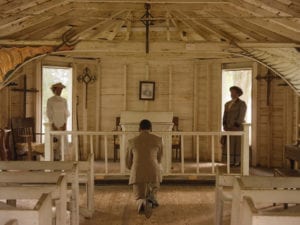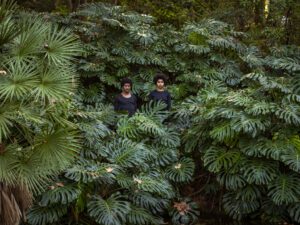“We’re in control of the future and the future is made by us” states Yinka Shonibare CBE RA (b. 1962). The British Nigerian artist creates thought-provoking pieces that challenge us to re-examine how we understand at the past, act in the present and imagine the future. He uses a variety of materials and media, from the Hibiscus Rising (2023) sculpture memorialising the life and tragic death of David Oluwale to statues clad in colourful, patterned wax print fabric – a hallmark of his practice. Now, Shonibare returns to London for his first solo exhibition in a public gallery in over 20 years. His work will once again be on view at Serpentine, where the multidisciplinary practitioner displayed as a finalist for the Barclays Young Artist Award in 1992. His new show is called Suspended States, and it will include a selection of installations, sculptures, pictorial quilts and woodcut prints that explore the legacies of European imperialism, migration, sites of refuge and the ecological impact of colonisation. It speaks to shows from other art institutions who are reckoning with these realities, such as the Royal Academy’s Entangled Pasts. In this interview, Shonibare speaks with Hans Ulrich Obrist, the Artistic Director of Serpentine, about his creative journey, the Black Arts Movement and pressing debates about today’s monuments to historical figures.
HSO: I’m interested in your beginnings: you were born in London in 1962, moved to Lagos when you were three and then returned to London in the 1980s to study fine art. How did you come to art? Did you have an epiphany at school in Nigeria?
YS: In Nigeria, there’s a local museum – an ethnographic museum set up by the British. Here, I found out about the Benin Bronzes. We used to do painting workshops and I wanted to study art but, in my family, this was seen as very strange because my father was a lawyer and he would rather I had that kind of profession. But when I came to London, I realised that I didn’t want to study law. I wanted to study art. After some battles with my family, I eventually went to art school. I went to the Byam Shaw School of Art and this was a very academic art school, with life drawing. It was basically promoting the London School of Art, like Leon Kossoff (1926-2019), Lucian Freud (1922-2011), and Francis Bacon (1909-1992). I met two people who were quite significant: Robin Klassnik and Jean Fisher. Robin Klassnik was running Matt’s Gallery, and he introduced me to the idea of contemporary art. Postcolonial texts and discourse was introduced to me by Jean Fisher, who taught at Goldsmiths College when I did my postgraduate studies.


HUO: It’s important to remember the rise of the Black Arts Movement as a radical political movement. Can you tell me how you relate to that movement?
YS: I knew all of these people. I knew Eddie Chambers (b. 1960), Keith Piper (b. 1960), Sonia Boyce (b. 1962), and John Akomfrah (b. 1957). I used to hang out with them and I used to go to their openings. I found them inspiring. I attended the opening of The Other Story exhibition at the Hayward Gallery in 1989. Rasheed Araeen (b. 1935) was invited by Robin Klassnik to do some lectures at Byam Shaw School of Art when I was there. Their strategy was a bit too didactic for me and I thought that it wasn’t as effective as it could be, even though I appreciated the pioneering nature of it and it was what was needed at the time. I decided that I had to take another route, I had to take more of a trickster route, to look at the system and then create a kind of artwork that I thought could challenge it from within. I was fed up with people being marginalised. There was a kind of defensiveness on the part of the art world. Galleries used to say then that there was no market for contemporary Black art so they couldn’t show it. I mean, it was quite an incredible thing. I decided that I just wanted to move in a different direction. I was in a very strange situation because I was also in Sensation in 1997 at the Royal Academy. So I moved between the two worlds.
HUO: Could you talk a little bit about print making, the wood block series Unstructured Icons, 2018, particularly, and what instigated that?
VS: Cristea Roberts wanted to work with me and I enjoy drawing. Before my career started as a painter, I’d always enjoyed drawing and painting. I used to make quite big paintings a long time ago and then, because of my physical situation, I decided that I couldn’t make those big paintings anymore but I could make prints. I could develop my work. I could figure out a way to disseminate some of these more serious issues in a populist way, because that’s the thing about print: it’s a very democratic medium. You can spread your ideas to so many people, whereas, politically, paintings are so expensive – you can’t have this level of distribution that you can with prints.
HUO: We’re including the series Unstructured Icons in the exhibition. How did you bring that together?
YS: The work is looking at icons of power. The history of modernism is very important to me, but throughout my art education, the influence of African masks and African aesthetics on modernism was vague. It would be mentioned in one lecture maybe, but it wasn’t really the most important part of it. African aesthetics contributed a significant amount to Western modernist aesthetics. Unstructured Icons uses those masks to deconstruct icons of Western power, and that’s how the series developed.

HUO: The theme of monuments connects many of your works, such as in your recent Decolonised Structures, 2022-2023, and the Monument Picture, 2022, quilt series. What are your current thoughts around the monument debates?
YS: When the Edward Colston (1636-1721) statue was pulled down in Bristol, Colston was known for his role in the enslavement of people, and these debates have continued. I think that within our contemporary world, it’s quite insulting to be celebrating a colonialist without any text or qualification to explain the situation. I don’t think statues should be destroyed, the public should be able to see them, but there should be museums built for them so people can understand the history of these people and what they did.
The Monument Pictures wasn’t necessarily me making a moral judgement about this, but capturing the zeitgeist of when the monument was pulled down. It evolved through trying to make sense of that particular incident. I wouldn’t encourage people to pull them down, because there has to be community consensus. But the space of art is a space in which anything can happen. You can create imaginary worlds in that space, which don’t correlate with reality, because obviously I’m not going to encourage public vandalism in that way.
The interesting thing about Decolonised Structures, especially painting them in very colourful patterns, is that I believe I’m making them more beautiful. In other words, I’m changing their character, or the history of their character, into something more interesting. But again, I’m not making a moral judgement there, I’m giving them a platform in which people can look at them and talk about them. lf you go to central London, these statues are everywhere, but we don’t notice them anymore because they’re just there. If you ask anyone who these people are, they don’t know for the most part. So, I’m refocusing attention on this.
HUO: How do you see the future?
YS: Adriano Pedrosa, who’s curating the 2024 Venice Biennale, Foreigners Everywhere, has invited me to show one of my refugee astronauts this year. I think the future is, for the most part, driven by your own optimism. I believe that you realise your own future. We’re in control of the future and the future is made by us. I think the future is the future you want to make.
Serpentine South, Yinka Shonibare CBE RA: Suspended States | Until 1 September
Image Credits:
- Wind Sculpture in Bronze IV, 2024. Courtesy Yinka Shonibare CBE and James Cohan Gallery. Photo: © Stephen White & Co.
- Yinka Shonibare CBE, Decolonised Structures (Queen Victoria), 2022, Fibreglass sculpture, hand-painted with Dutch wax pattern and wooden plinth, 139 x 75 x 57 cm. Commissioned by Sharjah Art Foundation. Courtesy of the artist and Goodman Gallery, Cape Town, Johannesburg, London and New York, James Cohan Gallery, New York and Stephen Friedman Gallery, London and New York. Photographer: Stephen White & Co. © Yinka Shonibare CBE.
- Yinka Shonibare CBE, Decolonised Structures (Roberts), 2022, Fibreglass sculpture, hand-painted with Dutch wax pattern goldleaf and wooden plinth, 180 x 70 x 149.5 cm. Commissioned by Sharjah Art Foundation. Courtesy of the artist and Goodman Gallery, Cape Town, Johannesburg, London and New York, James Cohan Gallery, New York and Stephen Friedman Gallery, London and New York. Photographer: Stephen White & Co. © Yinka Shonibare CBE.
- Yinka Shonibare CBE, Decolonised Structures (Frere), 2022. Fibreglass sculpture, hand-painted with Dutch wax pattern and wooden plinth, 143 x 49 x 60 cm. Commissioned by Sharjah Art Foundation. Courtesy of the artist and Goodman Gallery, Cape Town, Johannesburg, London and New York, James Cohan Gallery, New York and Stephen Friedman Gallery, London and New York. Photographer: Stephen White & Co. © Yinka Shonibare CBE.
- Yinka Shonibare CBE, Decolonised Structures, 2022-23. Fibreglass sculptures, hand-painted with Dutch wax pattern, gold leaf and wooden plinths. Dimensions variable. Commissioned by Sharjah Art Foundation. Courtesy of the artist and Goodman Gallery, Cape Town, Johannesburg, London and New York, James Cohan Gallery, New York and Stephen Friedman Gallery, London and New York. Photographer: Stephen White & Co. © Yinka Shonibare CBE.





